 |
| Amélie van Elmbt with her Dreaming Walls: Inside the Chelsea Hotel co-director Maya Duverdier and Anne-Katrin Titze on meeting Martin Scorsese: “It’s amazing, it really happened at First Time Fest.” |
When I was on the inaugural First Time Fest jury with the B-52s Fred Schneider, Killer Films Christine Vachon, and Gay Talese we gave Amélie van Elmbt the Best Director Award for Headfirst (La tête la première), produced by Frédéric de Goldschmidt and Best Actress to her star Alice de Lencquesaing (Elisabeth Vogler’s Années 20), daughter of the great cinematographer Caroline Champetier and Louis-Do de Lencquesaing (Emmanuel Mouret’s The Things We Say, The Things We Do). Martin Scorsese was on hand at The Players to present Darren Aronofsky the John Huston Award for Achievement in Cinema.
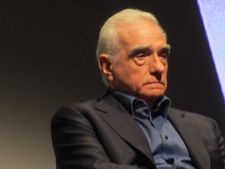 |
| Dreaming Walls: Inside the Chelsea Hotel Executive Producer Martin Scorsese Photo: Anne-Katrin Titze |
Dreaming Walls: Inside The Chelsea Hotel invites us into the skyline of Manhattan and then jumps in a taxi, very much reminiscent of Martin Scorsese’s Taxi Driver opening credits. Because, no surprise, the allure of the city actually never gets old, it only morphs and swirls around a mysterious core that the island possesses or is possessed by. Projected on the brick chimney on the roof of the Chelsea Hotel, we hear Patti Smith say “I’ve always liked to be where the big guys were.” And this is the place.
Whenever a beloved building or object is under renovation, disturbing the inertia of the Real, so to say, we fear of what will become of it. The Chelsea Hotel was precisely at this crossroads when the filmmakers stumbled upon it and decided to chronicle its current inhabitants who get a chance to speak their mind and show their creativity and the havoc caused by gentrification and a corporate mentality that endangers them. The ghosts of famous and illustrious occupants past linger in the background as though they were memories captured inside the walls, staircases, and stained glass windows.
Amélie van Elmbt and Maya Duverdier’s documentary celebrates the space given to individuals who do not or cannot conform to a capitalist machinery that pretends to see greed as normal and cruelty as the way of the world. The walls of the Chelsea since it was built in 1883, we can tell, dream of different things, messy maybe and also ambitious, but a great deal kinder and full of life.
From Brussels, Amélie van Elmbt and Maya Duverdier joined me on Zoom for an in-depth conversation on Dreaming Walls: Inside The Chelsea Hotel.
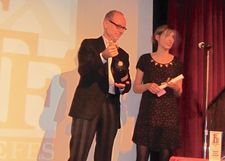 |
| Producer Frédéric de Goldschmidt with Amélie van Elmbt at the First Time Fest Awards Photo: Anne-Katrin Titze |
Anne-Katrin Titze: Amélie, we met many years ago at First Time Fest.
Amélie van Elmbt: Ah, yes!
AKT: I was on the jury with Gay Talese and Christine Vachon and Fred Schneider. And I remember that Martin Scorsese was at our awards ceremony. Is that where you met him? Is that how he became the Executive Producer of Dreaming Walls?
AvE: Yes, totally! Since then he’s been following my work. It’s amazing, it really happened at First Time Fest.
AKT: That’s great! It also happened at a place, The Players, with so much history and maybe ghosts. Your film is very much about spirit of place more than about prominent people. Did you sense that spirit when you first walked into the Chelsea Hotel?
Maya Duverdier: It’s true to say that we first entered because we felt a connection with the place and we knew the history and had all of this in mind, all the myths. Of course we felt a kind of energy because the building is full of history, of people, of ghosts also. I remember that when we were wandering in the hallways we were really feeling things. It inspired us also in a way.
AvE: It’s a combination because we were there by chance. Because my previous film was in Tribeca and we just encountered the place that was hidden by scaffolding and we had a strong encounter with one of the main characters, the dancer. Because we invited her to a screening she invited us to the Chelsea. After that we discovered the place and what was happening to this place with all the people still living there among the construction and renovation work.
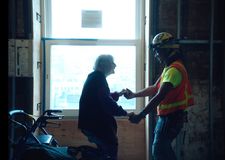 |
| Merle Lister dances with Pablo Photo: Clindoeilfilms, courtesy of Magnolia Pictures |
We decided there was a film to be made. Not about the famous names but about the people who are there and are part of the history of New York. The film is also like a trace of their existence, you know, to create an archive. They belong to the city. There are people also from the AIDS crisis who were pushed out of their apartments. It’s also a way to document those people.
There was a book that also inspired us, Sarah Schulman’s Gentrification of the Mind: [Witness to a Lost Imagination] about New York City and about how the white people from the suburbs entered the city and started to, let’s say, “colonize.” So we thought about this idea of keeping traces that are part of the history of New York that are never shown, especially in movies.
AKT: The film is filled with traces of the past of New York. I love the beginning with the skyline and then a little homage to Marty maybe? The start of Taxi Driver I thought of. Then you have Patti Smith say “I’ve always liked to be where the big guys were.” And then you show us everything but the big guys!
AvE: But in a way they all came exactly for the same reason, to be where the big guys were. Trying or willing to be one of them. Some succeed, others don’t. There are so many artists that we show some excerpts in the film, like Harry Smith, who is not so known. Thank god there is Anthology Film Archives, but otherwise nobody really knows about him. So we wanted to pay tribute to those who stayed, live and create there, like Bettina who is a really wonderful artist nobody really knows about.
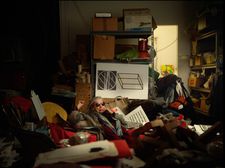 |
| Bettina Grossman inside her Chelsea Hotel apartment Photo: Clindoeilfilms, courtesy of Magnolia Pictures |
AKT: I noticed that you used a clip from Rosa von Praunheim’s Tally Brown, New York film. We see little glimpses of Marilyn Monroe; Arthur Miller wrote about the Chelsea Hotel. You show a dress by Charles James, the couturier who lived there. We see them for seconds, but the main idea is the building itself, that sheltered them. Merle Lister is your guide. A dancer on her walker with the name Merle, which means Blackbird, does some of the interviewing for you. Tell me about her!
AvE: She was the first person we met and we felt a great connection to her because she was dealing with the same things we’re dealing with, trying to express ourselves, being busy with the next creation she wanted to do. She knew everybody in the building so she lead us to everybody as well. There was this dance she performed that she was willing to perform again.
AKT: The reconstruction of the dance was done for your film?
AvE: That was part of her work. I had the feeling that because we were there, the energy of making the film also gave her the freshness to be able to reconnect to her work again. It was like an exchange. It was our presence, the gaze that we had on her, the exchange, that she felt confident, I guess, to bring this project back to life. Living under lockdown, the renovation, I think the fact that we were just the two of us at the beginning, very respectful to their lives, and being patient, coming back and forth and being interested in their lives, exploring their work - I think they felt alive again, let’s say, and the chance to show their work also.
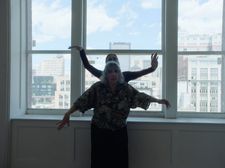 |
| Merle Lister with dancer Gina Healy Photo: Clindoeilfilms, courtesy of Magnolia Pictures |
AKT: There is a moment when the daughter of the artist [Skye Ferrante] who does the wire sculptures recites a Dylan Thomas poem [Do not go gentle into that good night]. Time seems to be expanding. She has this very strong voice for someone so young. Were you surprised by that moment too?
MD: Yes, and she knew it by heart. It was great to see such a pleasure in her eyes to perform this story for us. It was very moving also to see the emotion in her father’s eyes. We felt that he was very proud to transmit this experience, all this history. It was a moving moment.
AvE: Yes, we didn’t plan it, actually. It was really a book he had. I think, you know, when you come to perform or work as an artist in the Chelsea you know when you arrive what is behind and who was there before. You felt accepted by the place by also knowing and transmitting the work of the people who were there before to your family to your entourage. In a way she was fed by all of those references, like Rimbaud, like Verlaine, Honfleur [in Normandy], Debussy, Satie, all of those French names you cannot expect a young girl that age knowing.
MD: It’s a kind of heritage. Skye is an interesting character because he also plays the artist. And I think in another way this was a kind of performance by both of them to play the bohemian family
AvE: They are also. It’s my feeling about New York, also, where everybody knows the rules and you have to play a certain game to stay in the game.
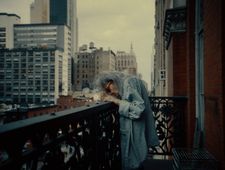 |
| Bettina Grossman on her balcony Photo: Clindoeilfilms, courtesy of Magnolia Pictures |
AKT: Yes, that’s good, very true. And they knew what they were doing, father and daughter. There is a bit of the New York magic trick. You intersected archival footage into your film, which in the beginning is projected on the brick chimney. The clip with Larry Rivers signing the painting in the lobby has the same feel of: here we are performing this for the camera. It doubles what you just talked about. How did you select the archival footage?
AvE: It was a very long process because there are the famous ones, like the one of Larry Rivers you mentioned, from the BBC. But then as we were working on the editing, archival material kept coming, adding itself to all the material we already had. In the beginning it was a bit like playing with a puzzle, not knowing what will be the final image of it. We were working for about a year on that editing and by knowing by heart all the material, organic connections started to form by themselves.
The material organised itself because we had the knowledge of the place, also living in the place when we were shooting, knowing the people, the archive, the backstory of those people. There is also the archive of Nelson Sullivan that documented the Eighties and the Nineties of New York underground and that became of use. It was kind of an internal process.
MD: I think it’s important to say that we wanted to give place to anonymous people in the archives. In general people like to see famous people but for us it was very important to also have people at the same level as our characters who are also unknown. It was a way to show that everybody was living together and is part of this history, even if unknown. We asked the residents also for personal archives and it was great to mix.
 |
| Dreaming Walls: Inside The Chelsea Hotel poster |
AKT: Some of the famous people come in only at the very end with the credits, Frida Kahlo and Christo. No Mark Twain, no Sam Shepard or Tennessee Williams. The more you look into this building, the more it grows. It was built in 1883, but it feels, also very much so in your film, as if it hasn’t been finished. As if the renovation is integral to its existence and every generation, every year, is helping to finish it by the artworks, from Andy Warhol to your film. You feel that way too?
AvE: Completely.
MD: Yes, you have a beautiful way of seeing things.
AvE: Yes, of seeing it! It’s like an endless cycle that is always starting again. It’s never done.
MD: We can always be surprised. It’s like a phoenix that always goes through rebirth. Of course we have to say that this very moment is strong because the world outside is getting tougher and tougher.
AvE: In April we were there. Because of the pandemic we couldn’t come back for a long time so we visited and saw that the rooms were really expensive now, like 800 a night or something like that. We were a bit sad, also sad because the spirit of the Chelsea was also linked to the way that you could have a room for nothing. The mix of the building was linked to the possibility of having a room for very cheap.
So now there will be a homogeneity in the population of the Chelsea Hotel. Except our characters who are still there. It’s sad to see that this building that resisted with time and kept lower rent is now being changed. There were other films that were centred on the big names and the “ghost stories” in a sensational sense and it was for us very important in this very moment at the Chelsea, this transformation, to keep the story alive also with those people.
AKT: You do this especially with the very powerful image at the end with Bettina Grossman on the walker, with her grey hair, on the street outside. It is haunting also because of the impressive sound design.
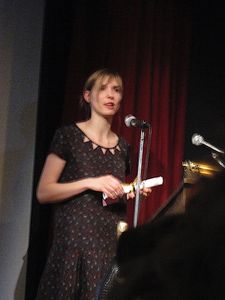 |
| Amélie van Elmbt accepting the First Time Fest Best Director Award for Headfirst Photo: Anne-Katrin Titze |
AvE: That was also the contribution of Michael Andrews who I knew from my previous film. He helped us a lot and gave us some tracks of voices or strange noise that we distort and work with, which was great. We had a precise idea but we worked like hell because we wanted to have this feeling of the past and not be very obvious about it. So it was really minimal and precise.
MD: Like dentelle [lace].
AvE: We basically took sound from archive and distort and transform it as if it was swallowed. For example there is an excerpt of Nico brushing her hair. We use a part of the film Chelsea Girls but we distort it. Everything you hear is linked to what you see but deformed and with delay.
AKT: And that image of Bettina on the street?
AvE: For us it’s kind of an iconic image of the film.
MD: It’s a metaphor of the whole film. She was still here, carrying all the stories
AvE: And everybody in New York is walking by, not even paying attention to her. But she’s there! For us it’s a representation of why we wanted to make this film, to show those people that are still there, even if people don’t want to see them. They constitute the life, the essence of New York City.
MD: It was really a big statement for us to put Bettina at the end as if after all that happened she was like the only one staying in the hotel. It gives the feeling of oh, there is still someone inside!
AKT: Thank you so much for an impressive film. So nice to meet you Maya and great to see you again Amélie!
AvE: Yes, thank you so much!
MD: Thank you so much for your words. It was great!
Dreaming Walls: Inside The Chelsea Hotel opens at the IFC Center on Friday, July 8 and will be available on Video on Demand from that day.





















